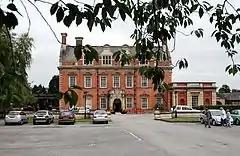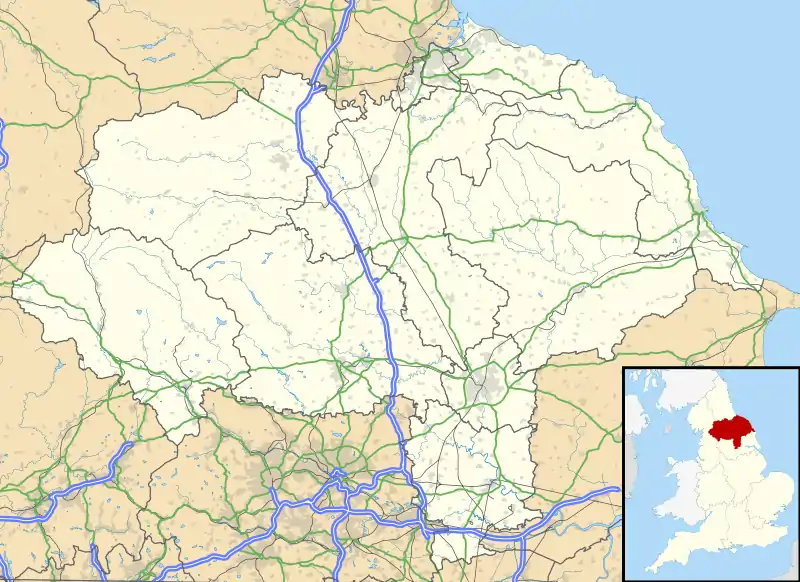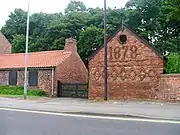Acklam, Middlesbrough
Acklam is a suburb, former separate settlement, of Middlesbrough and its government area. The area is in North Yorkshire, England.
| Acklam | |
|---|---|
 Acklam Hall | |
 Acklam Location within North Yorkshire | |
| Population | 6,027 (2011.Ward)[1] |
| OS grid reference | NZ477168 |
| Unitary authority | |
| Ceremonial county | |
| Region | |
| Country | England |
| Sovereign state | United Kingdom |
| Post town | MIDDLESBROUGH |
| Postcode district | TS5 |
| Dialling code | 01642 (Middlesbrough) |
| Police | Cleveland |
| Fire | Cleveland |
| Ambulance | North East |
History
Manor of 1068
Acklam was referred to as "Aclun" in the 1086 Domesday Book. It is believed that the name is Anglo-Saxon Old English for "place at the oak clearings" or "place of oaks".[2][3] A precursor to a parish , the 'manor' of 11 gold tax-able ploughland in Acklam and Ingleby Barwick, what would have been equally largest settlements in these plough-lands at the time. This manor’s area had previously been owned by Earl Siward with the area passed to Hugh Earl of Chester in 1086.
This manor’s jurisdiction extended over 24 plough-lands in Coulby farm, Hemlington, Stainton, Thornton, Maltby and Thornaby. Also listed were the later abandoned Stainsby and a Cold Ingleby, a settlement thought to have been on cold pool beck west of Newby and between Thornton and Seamer.[4][5]
Stainsby
To the west of current Acklam, is the abandoned medieval settlement of Stainsby, deserted by 1757. Today this amounts to little more than a series of grassy mounds near the A19 road.[6]
Overlords (1068–1488)
In the Manor area, Robert Malet had a ploughland and the king also had 3 ploughlands, royal lands included in Robert de Brus’ fee-ing. When Malet’s son died in a pub, the White Ship, around 1120 meant all lands went to the king.
An agreement between Whitby Abbey and Guisborough Priory, by 1138, mentions the 4 ploughlands in Acklam held by the line of Robert de Bruces. Last in the line of Brus, Robert I of Scotland, in 1279 held a knight's fee of half a ploughland along with three parts of a knight's fee between 1284–5.
Over-lording of Acklam came to Lucy de Marmaduke (nee Brus), Lucy de Thweng and, in 1346, to Lucy and John Darcy. Acklam passed down the Darcy line until Sir Richard Strangways, son of Lucy and John's great-great-granddaughter Elizabeth, overlorded until his death in 1488. Thomas Boynton had gained powers as lord and tenant from Richard, upon Richards death overlordship ended.[7]
Lords (1086-1460/1)
Hugh son of Norman, Earl Hugh's tenant in 1086, was thought to be succeeded by Alvered, or Alfred, in about 1120. Roger, son of Alvered's grandson, William de Acklam had two daughters. Joan was sole heir after her sister's death:
- Joan married Ingram de Boynton.
- Their heir, William de Boynton, in 1284–5 was lord and had been living in Acklam since atleast 1256.
- Ingram, William’s son had became lord by 1303.
- Son Walter followed, until 1340,
- Thomas and Katherine 1365
- Sir Thomas Boynton II, succeeded in 1402
- Thomas's son, Henry, was executed three years later for joining the Percy rebellion.
The manor area was merged with Kirk Leavington, under Roger Thornton and was in his possession in 1428, later reverting to the Boynton line:
- William, Henry’s second son, is said to have held the area after the death of his brother Thomas.[8]
Land holder (1460/1-1637)
In 1460-1 Thomas son of Thomas, also heir of William, died as lord of Acklam.
- From his son Henry, who was dead in 1495, the manor came in direct line to Henry's grandson Matthew, seised at his death in 1540, when he left a son Thomas, aged three.
- Thomas was succeeded in January 1581 or 1582 by his son and heir Francis, lord in 1613 and thought to last until 1617.
- Twenty years later Acklam was sold by his son Sir Matthew Boynton, baronet, to William Hustler.[9]
Overshadowed
In the late 19th and early 20th centuries, this once tiny village passed from Stokesley Rural District, to Middlesbrough Rural District and was eventually incorporated into the county borough of Middlesbrough during the early 20th century.[10]
Geography
Acklam is situated in West Middlesbrough, and encloses smaller estates such as Kader, And Trimdon Avenue Estate. Acklam Road runs directly through Acklam, and just off Acklam Road is Hall Drive. The previous focus of the parish was the residence of the Hustler family, the Restoration mansion of Acklam Hall,[11] this is shown in maps of the pre-industrial area—such as the 1714 Lordship of Acklam Plan—in the nearby Dorman Museum in Linthorpe. The house, formerly a grammar school and Middlesbrough's sole Grade I listed building,[12] had ceased to be the Acklam Campus of Middlesbrough College by the middle of 2008.[13]
 Former blacksmiths on Acklam Road
Former blacksmiths on Acklam Road St Mary’s Church
St Mary’s Church_-_geograph.org.uk_-_80109.jpg.webp) The Devil’s Bridge
The Devil’s Bridge
Education
Acklam schools, include Kader Primary School, Acklam Grange School, Outwood Academy Acklam, Acklam Whin Primary School and St Clare's Primary School, on Trimdon Avenue. Acklam Grange Secondary School was previously Stainsby Secondary Modern School, named as such in 1952 after the mediaeval settlement of Stainsby.
Notable people
- Bob Mortimer – comedian and actor[14]
- Pete Firman – comedian and magician[15]
- Chris Rea – singer songwriter[16][17]
- Brian Clough – footballer and football manager[18]
- Elizabeth Carling – actress[19]
- Steph McGovern – BBC business reporter[20]
- Andy McDonald – Member of Parliament for Middlesbrough, was born in Acklam[21]
- Alan Hughes MBE – vicar of Berwick and Canon of Newcastle Cathedral[22]
References
- "Area: Acklam (Ward)". Neighbourhood Statistics. Office for National. 1 January 2007. Retrieved 22 July 2015.
- Matthews, A. D. (1987). Acklam Hall: A House and Its History. ISBN 0951234307.
- Mills, Anthony David (2003); A Dictionary of British Place Names, Oxford University Press, revised edition (2011), p.3. ISBN 019960908X
- William Page, ed. (1923). Parishes: Acklam. A History of the County of York North Riding: Volume 2. Victoria County History. pp. 221–223. Retrieved 15 January 2021.
- "Explore Georeferenced Maps - Spy viewer". National Library of Scotland. Retrieved 17 January 2021.
- "Stainsby Medieval Village". Tees Archaeology. Archived from the original on 13 May 2012. Retrieved 20 December 2007.
- William Page, ed. (1923). Parishes: Acklam. A History of the County of York North Riding: Volume 2. Victoria County History. pp. 221–223. Retrieved 15 January 2021.
- William Page, ed. (1923). Parishes: Acklam. A History of the County of York North Riding: Volume 2. Victoria County History. pp. 221–223. Retrieved 15 January 2021.
- William Page, ed. (1923). Parishes: Acklam. A History of the County of York North Riding: Volume 2. Victoria County History. pp. 221–223. Retrieved 15 January 2021.
- "West Acklam Ch/CP/AP through time | Census tables with data for the Parish-level Unit". www.visionofbritain.org.uk. Retrieved 13 November 2017.
- Historic England. "Acklam Hall (Grade I) (1136868)". National Heritage List for England. Retrieved 13 November 2017.
- "Acklam Hall in Middlesbrough reopens following renovation". ITV News. 18 February 2016. Retrieved 13 November 2017.
- Smiles, Mieka (28 March 2017). "See inside Kirby College before its demolition". Gazette Live. Retrieved 13 November 2017.
- "Mortimer's Teesside: Bob Mortimer lists his favourite places in our area". Gazette Live. 2 December 2014. Retrieved 27 December 2016.
- "From card ace to TV stardom". gazettelive. 3 February 2003. Retrieved 4 June 2017.
- Fletcher, Kevin (2011). Are You Affiliated?. Lulu. p. 128. ISBN 978-1-4466-8784-0.
- Smiles, Mieka (27 October 2017). "What's it like to live in Acklam in 2017?". Gazette Live. Retrieved 13 November 2017.
- Francis, Tony (1993). "1: Hey, Young Man". Clough; a biography (3 ed.). London: Stanley, Paul & Co. p. 9. ISBN 978-0-0919-4748-4.
- "Liz Carling". Gazette Live. 27 April 2001. Retrieved 13 November 2017.
- Webber, Chris (25 November 2014). "Teesside TV presenter Steph McGovern sent £20 to tone down Teesside accent". The Northern Echo. Retrieved 13 November 2017.
- "Andy McDonald chosen as Middlesbrough Labour candidate in by-election to replace the late Sir Stuart Bell". Darlington and Stockton Times. 4 November 2012. Retrieved 30 November 2011.
- Daniel, Brian (9 November 2012). "Berwick Parish Church vicar retires after 18 years tending flock". Journal Live. Retrieved 13 November 2017.
External links
 Media related to Acklam, Middlesbrough at Wikimedia Commons
Media related to Acklam, Middlesbrough at Wikimedia Commons- Acklam in the Domesday Book